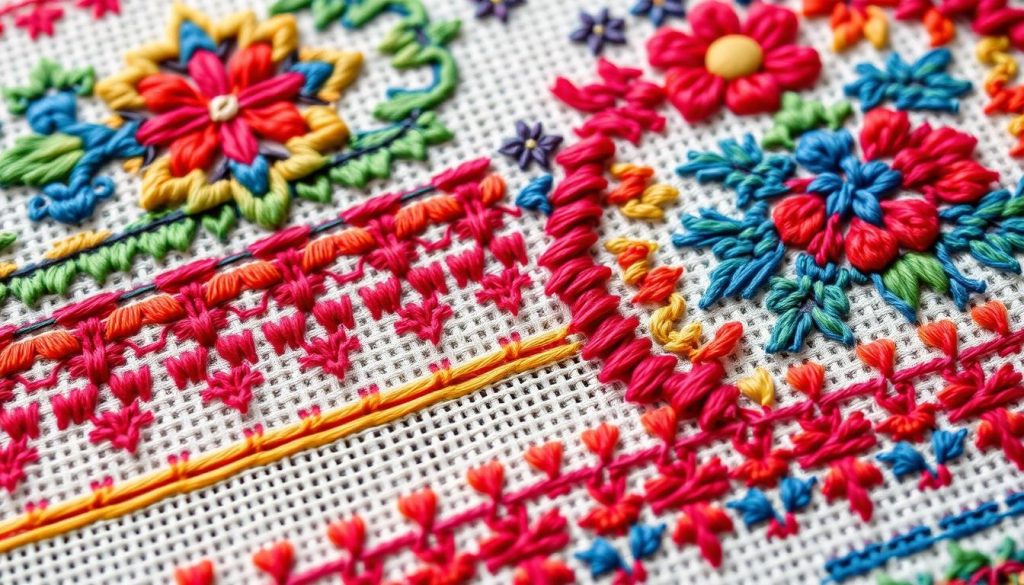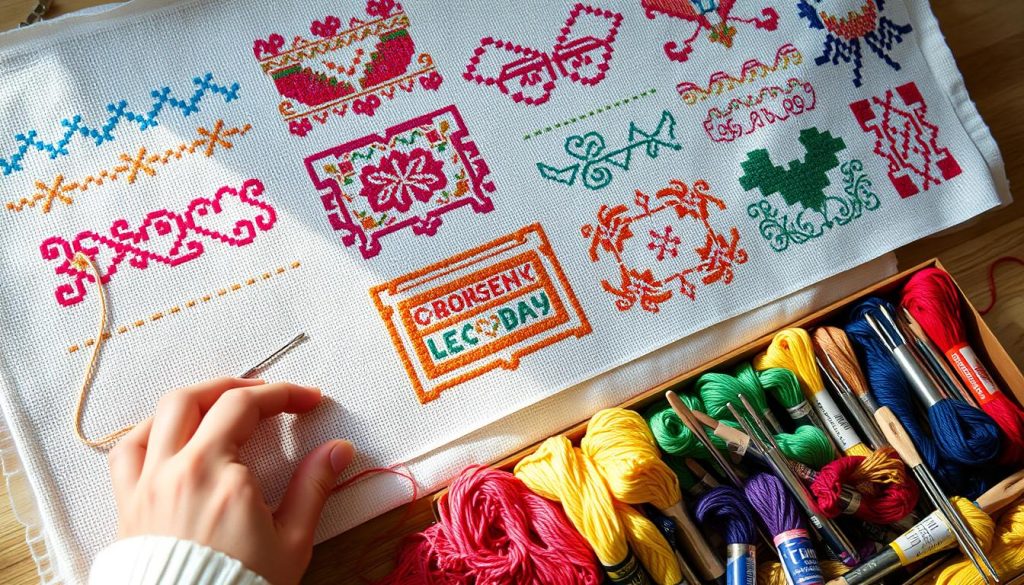Starting with cross stitch can be thrilling, but beginners often ask about the stitch direction. Knowing about cross stitch techniques, like the direction, can make your work look professional. This detail affects how your embroidery looks and holds up.
As you learn cross stitch tips, you’ll see that each cross is made of two stitches. This ensures your work is even and neat. Sticking to one direction makes your project look uniform and polished. This is key since even weave fabric has small squares that need to be fully covered by your stitches.
Using the right amount of thread is also important. It makes sure your cross-stitch looks detailed. Keeping the thread count consistent also helps with texture and coverage. Plus, checking for thread twists helps avoid stitches that show too much background fabric.
It’s common to start stitching from the center of your pattern and fabric. Stitchers often finish all half stitches of one row before moving on to the cross stitches. This helps avoid mistakes. Working from left to right and securing the thread before starting again also keeps your work neat and consistent.
Key Takeaways
- Crosses in cross-stitch are made of two stitches, ensuring even and neat work.
- Consistent stitching direction provides a professional appearance.
- Using enough strands of thread ensures a well-executed cross-stitch.
- Regularly check for thread twisting to avoid uneven stitches.
- Starting in the center of the fabric and pattern is common practice.
- Complete all half stitches before finishing cross stitches to avoid errors.
- Work from left to right along the pattern to maintain neatness.
The Common Practice in Cross Stitch Direction
In the world of cross stitch, direction is key. While there’s no strict rule, some methods are more popular. The direction you choose can change how your project looks.
The Preferred Way: Bottom Left to Top Right
About 73% of cross stitch fans start from the bottom left to the top right. This method fits well with design layouts and looks smooth. It’s also good for right-handed people, as it matches their natural hand movement.

Why Most People Stitch Left to Right
Stitching from left to right follows English reading direction, making it easy for many. It’s also common in free cross stitch patterns and guides. Fabrics like Aida and linen work well with this method because of their grid system.
Direction Preferences Among Stitchers
Even though some prefer certain directions, everyone has their own way. Some choose based on the project’s complexity or look they want. Personal taste is important, and many adjust their methods for their projects. Kits help people try different directions, showing the craft’s flexibility.
| Method | Preferred Direction | Material |
|---|---|---|
| Bottom Left to Top Right | 73% | Aida, Linen |
| Left to Right | Aligns with English reading | Common in guides |
| Variable | Based on personal preference | Projects specific |
Understanding the Impact on Your Cross Stitch Projects
The way you stitch affects your cross stitch projects a lot. Stitches going in the same direction make your work look clean and professional. This also helps when you wash and iron it.
Visual Consistency and Aesthetic Appeal
Getting your stitches to look the same is key in cross stitching. When they do, your work shines more because it reflects light evenly. This is crucial for competitions, where judges check both sides for neatness.
Using top-notch threads like DMC helps a lot. It cuts down on knots, making your work look smoother. Avoiding cheap threads keeps your fabric smooth and prevents knots that mess up the look.
Impact on Wash and Iron Practices
Washing and ironing your cross stitch right is important. Stitches going in the same direction help your fabric stay even. This makes it less likely to get distorted when you wash it.
Using tips for washing, like pin stitches, helps too. It keeps threads from showing when you stitch. A piece with uniform stitches is also easier to iron. This keeps your project looking great for a long time.
Cross Stitch Techniques to Consider

Exploring different cross stitch methods can make your embroidery projects look better. It’s important to decide between the complete stitch and half stitch method. Also, keeping your top stitches even is key for a polished finish.
Complete Stitch vs. Half Stitch Method
The choice between complete and half stitch methods affects your work’s texture and coverage. The Danish method is loved by experts. It involves finishing one row of half stitches and then returning to complete each cross. This is great for solid threads like DMC.
The English or Victorian method is better for variegated floss. It ensures color consistency by completing each stitch one at a time.
Here’s a quick look at both methods:
| Method | Preferred Threads | Advantages |
|---|---|---|
| Danish Method | Solid Threads (e.g., DMC) | Ensures smooth coverage, ideal for detailed designs |
| English or Victorian Method | Variegated Floss | Maintains color consistency in each stitch |
The Importance of Uniform Top Stitches
Having uniform top stitches is crucial for a clean and consistent look. Keeping all top stitches in the same direction helps avoid pattern disruptions. This is a key point in many cross stitch tutorials.
Using tools like hoops or Q-Snaps helps keep your stitches even. Techniques like railroading ensure your stitches are flat. Choosing the right fabric is also important. Evenweave fabric is best for its flexibility and even stitches.
For 16ct or 32ct fabric, use 2 strands of floss. For 14ct or 28ct fabric, 3 strands are better for coverage.
In summary, mastering advanced cross stitch methods requires attention to detail and the right materials. Whether you’re making intricate designs or simple patterns, these techniques can take your work to the next level.
Does Changing Directions Benefit Your Cross Stitch?
Trying out different stitching directions can really help with DIY cross stitch projects. For example, changing the way you do half crosses can add cool texture and contrast. Many English designers love using half cross stitches, making your designs more interesting.
There’s no one right way to do half cross stitches, as it depends on personal taste. Some stitchers choose based on what they see in finished designs. Others pick based on how the pattern looks overall. This makes your cross stitch projects even more special.
Using threads with different colors and changing stitch directions can make your work look amazing. For instance, stitching each half of a cross twice or mixing colors can create a cool ‘internally variegated’ look. This trick is great for making your designs look more real and detailed.
Here are some things to think about when deciding to change stitch directions:
- Creating texture and depth: Switching up stitch directions can make your work more interesting to look at.
- Reflecting light and color: The way you stitch can change how colors look and how light reflects off them.
- Mimicking natural elements: Drawing inspiration from nature can help you choose the right stitch directions and colors.
Most stitches can be changed by reversing their direction. For example, you can make diagonal stitches symmetrical or create cool patterns like Alternating Mosaic or Alternating Diagonal Gobelin. This opens up a world of possibilities in your custom cross stitch projects.
In the end, while traditional cross stitch values uniformity, trying different directions can make your work stand out. It’s key to experiment and find what works best for your designs. Always think about the overall look and what you want to achieve.
Conclusion
Within the cross stitch community, there are many ways to stitch. People often pick their method based on what they like and what their project needs. Forums and blogs show that everyone has their own way of doing things.
Choosing how to stitch can really change how your project looks. It’s not just about following rules; it’s about making something you love.
Planning well is key to a great cross stitch project. For example, knowing how much thread you need can save you from waste. Following instructions carefully helps avoid mistakes and makes your work look better.
Knowing the cost of materials is also important. This helps you stay within your budget and manage your project better. This way, you can enjoy making your cross stitch without worrying about money.
The world of cross stitching is always changing. More and more people are joining online forums and blogs. This shows how popular and meaningful cross stitching is today.
Whether you’re an experienced stitcher or just starting out, there’s always something new to learn. The variety of stitch directions and methods lets you express yourself in many ways. It’s a craft that keeps on giving, offering endless possibilities for creativity.
